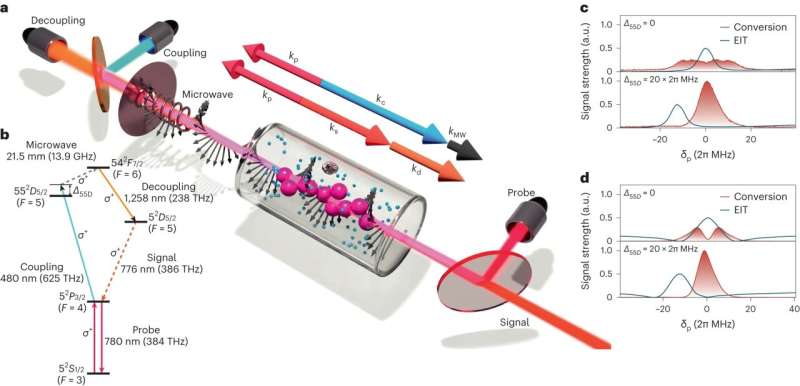This article has been reviewed according to Science X's editorial process and policies. Editors have highlighted the following attributes while ensuring the content's credibility:
fact-checked
peer-reviewed publication
trusted source
proofread
Discovery may enable network interface for quantum computers

A team of scientists at the QOT Centre for Quantum Optical Technologies, including a student from the Faculty of Physics (University of Warsaw), made a device capable of the conversion of quantum information between microwave and optical photons.
The results of research, published in Nature Photonics, highlight a new microwave detection method with possible applications in quantum technologies, as a part of quantum network infrastructure, and in microwave radio-astronomy.
Conversion of quantum information
Whenever you listen to a song on your phone or computer, a conversion of information happens—a file digitally encoded in your device's memory is converted to an electric current driving your headphones. Similarly, we can convert quantum information encoded in photons—the smallest quanta of light.
For example, we can transfer information from a single microwave photon to a single optical photon. However, devices capable of single-photon operations are quite difficult to realize, because they need to be very precise and introduce very little noise. Additionally, what makes the task challenging is the fact that optical photons have energy ten thousand times larger than microwave photons and there are few media capable of simultaneously interacting with both species.
Still, the conversion of quantum information is pivotal to hybrid quantum networks—networks connecting different quantum devices, such as quantum computers. Quantum computing can be realized with microwave photons interacting with superconducting circuits, though the long-distance transfer of quantum information encoded in this manner poses a challenge due to the accumulation of noise.
However, this is no longer a problem for optical photons, which can efficiently send quantum information via optical fibers. Therefore, the microwave-to-optical converter of quantum information can be a crucial part of a quantum network adapter—an interface between quantum computers and the quantum internet.
Enlarged atoms
One known medium that can interact both with microwave and optical photons are Rydberg atoms, named after Johannes Rydberg, who researched optical spectroscopy at the turn of the 19th century and stated the famous Rydberg formula. Rydberg atoms can be produced via laser excitation of valence electrons e.g. in rubidium atoms.
This causes the atoms to increase their size a thousandfold and acquire many interesting properties, which are a hot research topic all over the scientific world. In this case, it is important to know that Rydberg atoms are very sensitive to microwave radiation.
So far, microwave-to-optical conversion has only been demonstrated in laser-cooled atoms caught in complex magneto-optical trapping setup. The scientists at the University of Warsaw are the first to show that microwave-to-optical conversion can be realized at room temperature, in atomic vapors inside a glass cell.
The proposed design of the converter is notably simpler and can be further miniaturized in the future. Additionally, the new conversion scheme shows very low noise levels and therefore can perform operations even on single photons. Even though the new converter setup is much simpler, the parameters of the conversion are surprisingly better.
In particular, the invention made at UW can work non-stop, as the atoms do not have to be prepared in a specially designed time sequence, which can take up more than 99% of the devices' operational time in experiments done by other groups.
Using the converter device, the scientists at UW have demonstrated the detection of microwave thermal radiation at room temperature—for the first time it has been done without using microwave antennas or special low-noise amplifiers. To get to the thermal level, the device has to be sensitive to single photons, but nevertheless, the converter can work for microwave radiation a million times stronger and cannot be damaged with even stronger fields, in contrast to other standard microwave devices.
The future lies in microwaves
The rapidly developing quantum technologies use various information carriers. Quantum computers based on superconducting junctions store their information in microwave frequencies, whereas quantum memories are largely based on optical photons. Similarly to the quantum network adapter, the interconnection between the two types of devices requires an interface that can efficiently work both in microwave and optical domain. Rydberg atoms are being presented here as the solution.
Single-photon microwave operations will be important in astronomical observations researching the properties of distant bodies or the shape of the early universe via measurements of the cosmic microwave background. Until now, measurements retaining quantum information in microwave photons have not been possible and microwave-to-optical conversion may create a whole new branch of microwave radio-astronomy.
Everyday mass communication can also benefit from the discoveries in microwave detection. Next-gen mobile technologies are set to heavily utilize high frequency microwave transmission bands, difficult to emit and detect in conventional electrical circuits. One day, atomic microwave sensors may be a crucial part of high-speed internet connection.
This is why in the Centre for Quantum Optical Technologies QOT, as well as in scientific institutes all over the world, there is ongoing research on how to employ quantum technologies in ultrasensitive microwave detection.
More information: Borówka, S. et al. Continuous wideband microwave-to-optical converter based on room-temperature Rydberg atoms. Nature Photonics (2023). DOI: 10.1038/s41566-023-01295-w. www.nature.com/articles/s41566-023-01295-w
Journal information: Nature Photonics
Provided by University of Warsaw



















